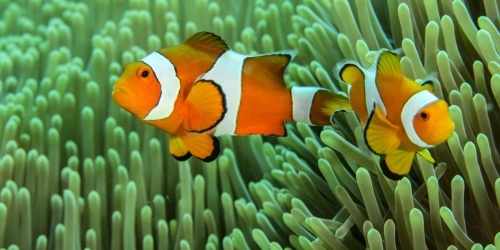
Potato Cod - Photo the Ocean Agency / Adobe
What is a potato cod? As it is very large, has distinctive markings and is quite friendly, the potato cod is a favourite with divers. As this species has been fished out from most other parts of the world, we are very lucky in Western Australia that divers can still come face to face with them in places such as the Rowley Shoals Marine Park. Named after the large potato-shaped markings on its body, the potato cod (Epinephelus tukula) is one of the biggest members of the groper family.
What do they look like? Potato cods can reach two metres long and weigh approximately 100 kilograms. The average adult is 1.5 metres long, weighing about 90 kilograms. Potato cods are a pale bluish-grey colour and covered with large dark brown or black blotches. There are dark spots and streaks on their head. Very large adults are reported to be almost entirely black.
Where do they live? Potato cods are found mainly in the tropical and subtropical waters of the Indian and Pacific oceans. They live among coral reefs and move around the bottom of the reefs looking for food. Juveniles are found in the shallow water of reef tide pools, while adults occur in depths of 10 to 150 metres. Most large potato cods live by themselves in the same reef area, often for years. In WA, potato cods can be found around the north-west coast, from Ningaloo Marine Park to the proposed North Kimberley Marine Park, although the fish are occasionally encountered further south. As well as at Ningaloo, you can find potato cods in the Montebello Islands Marine Park, the proposed Dampier Archipelago Marine Park and they love to hang out at the Rowley Shoals Marine Park.
What they eat and how: Potato cods eat small rays, crabs, fish, squid, octopuses and western rock lobsters. They like to ambush their prey by hiding behind lumps of coral until their food swims past. They then lunge quickly to grab their meal. The cod's head and mouth are so large that it can envelope prey in one huge gulp!
Threats: As potato cods live in the same area throughout their entire lives and show little fear of people, they are easy targets for spearfishers. This is one reason why the potato cod is completely protected in WA.
Behaviour: Although there are no records of potato cods being aggressive towards people, divers still need to be careful as these massive fish have powerful jaws that could potentially inflict serious injuries.
Breeding and caring for young: Members of the groper family are 'protogynous hermaphrodites'. This means that when they become sexually mature (at about 90 centimetres long), gropers start out as females, but undergo a sex change during their lives to become males! They get together in groups when ready to spawn. Each fish might swim several kilometres to get to the spawning site. This is a long distance for potato cods as they don't usually swim too far.
Conservation status: These fish are one of our marine wonders and should not be molested or speared. They may live for decades and there are very few in any given location, so large animals would take many years to be replaced. This species is totally protected in Western Australian waters and may not be taken.
How you can protect the potato cod: If you should accidentally catch one while fishing, return it to the water immediately. If you are ever lucky enough to encounter one in the water, look at it but don't touch and keep a safe distance from it.



























